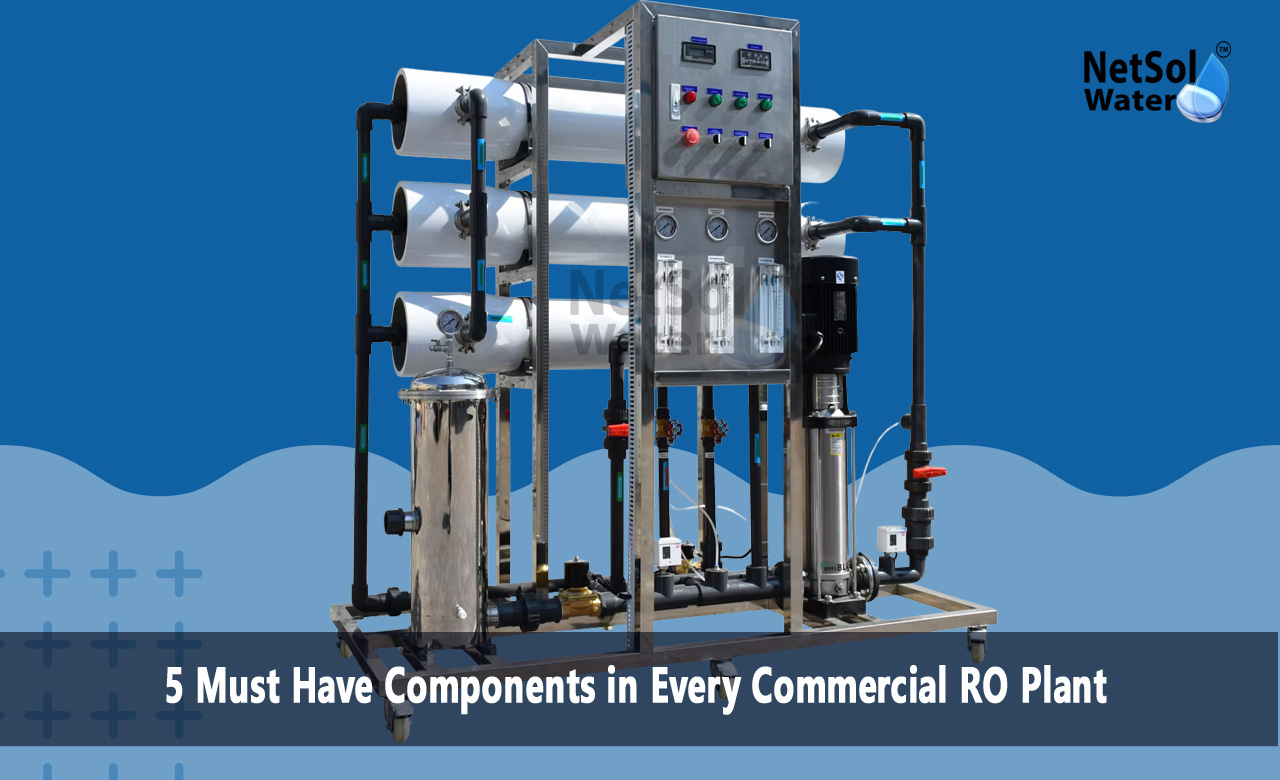5 Must-Have Components in Every Commercial RO Plant
Commercial RO plants serve many industries that need clean water for production processes and daily operations. A reliable system can prevent downtime and protect equipment from damage. Netsol Water stands out as a leading commercial RO plant manufacturer in the field of water treatment solutions. It builds systems that meet strict performance and safety standards. Understanding the 5 key components in every commercial RO plant helps you choose the right system. These components shape how efficiently the plant can remove impurities and maintain output. They also influence operating costs and ease of maintenance. Here we explore each component and explain why it matters for any commercial application.
1. Pre Filtration Unit
Before it reaches the RO membranes water must pass through pre filters that remove large particles and organic matter. Proper pre filtration extends membrane life and improves overall plant performance. Let us have a look at some essential stages in this unit and see how they contribute to system reliability.
Sediment Filter: The sediment filter removes sand and silt. It acts as the first stage against visible particles. It operates under low pressure and traps debris in its porous layers. This prevents blockages in downstream components.
Activated Carbon Filter: After sediment removal water flows through activated carbon. This stage adsorbs chlorine and organic compounds. It protects membranes from chemical damage. It also improves taste and odour of the treated water.
Multimedia Filter: A multimedia filter uses layers of gravel sand and anthracite. These layers capture fine particles left by earlier stages. The graded media design boosts flow and backwash efficiency. It ensures a consistent removal rate over time.
2. High Pressure Pump
A high pressure pump pushes pre filtered water into the RO membranes. It must generate enough pressure to overcome osmotic forces. Proper pump selection can cut energy use and lower operating costs. Let us have a look at some factors that make a pump suitable for commercial use.
Flow Rate Capacity: The pump must match the plant output requirements. A pump with the right capacity prevents pressure drops. It keeps systems running at design specifications.
Material Construction: Pump components must resist corrosion and abrasion. Manufacturers use stainless steel or reinforced composites. These materials extend pump life under continuous operation.
Efficiency Rating: High efficiency pumps use less power for the same output. This can save thousands on energy bills. An efficient pump makes the entire RO plant more economical.
3. RO Membrane Modules
Membrane modules form the heart of any RO plant. They separate dissolved salts and impurities from water. The quality and type of membrane affect recovery rates and purity levels. Let us have a look at some membrane features that matter in a commercial setting.
Membrane Material: Manufacturers use thin film composite membranes for their high rejection rates. These membranes block up to 99 percent of salts. They also resist biological growth and chemical attack.
Module Configuration: Membranes come in elements and cartridges that fit into pressure vessels. Proper sizing and arrangement ensure uniform flow distribution. This maximizes recovery and extends membrane life.
Operating Pressure: Each membrane type has an optimal pressure range. Running below this range lowers output. Operating above can damage the membrane. Control systems must monitor and adjust pressure for best results.
4. Post Treatment System
After water exits the membranes it may need further polishing or adjustment. Post treatment ensures the water meets specific quality standards. Let us have a look at some common post treatment options that enhance final water quality.
pH Adjustment: RO water can become slightly acidic. It may harm pipes or affect processes. A pH adjustment system adds alkaline media to balance the final water pH.
UV Disinfection: A UV lamp can inactivate any remaining microorganisms. It delivers water that meets drinking water norms. UV systems require minimal maintenance and no chemical additives.
Mineral Addition: Certain applications need water with specific mineral content. A mineral dosing system adds calcium or magnesium salts. This helps protect boilers and heat exchangers from corrosion.
5. Control Panel and Instrumentation
A control panel ties all components together and keeps the plant running smoothly. It monitors key parameters and alerts operators to any issue. Let us have a look at some control features that boost uptime and safety.
Pressure Gauges and Flow Meters: These instruments track pressure and flow at each stage. They help detect blockages or pump failures early. Operators can tune settings for peak performance.
Automated Valves: Automated valves can start and stop flows without manual intervention. They allow for automatic backwash and cleaning cycles. This reduces downtime and labour costs.
PLC and HMI Interface: A programmable logic controller with a user interface lets staff view system status at a glance. Alarm conditions appear in real time on the touch screen. This helps teams respond quickly to any deviation.
Conclusion
Every commercial RO plant needs these 5 components to deliver reliable performance and consistent water quality. As a trusted commercial plant manufacturer, Netsol Water manufactures systems that integrate each element for peak efficiency. If you seek a custom solution or expert advice please get in touch with our team today. Request a consultation and learn how our tailored designs can meet your water treatment goals.
Contact Netsol Water at:
Phone: +91-9650608473, Email: enquiry@netsolwater.com



